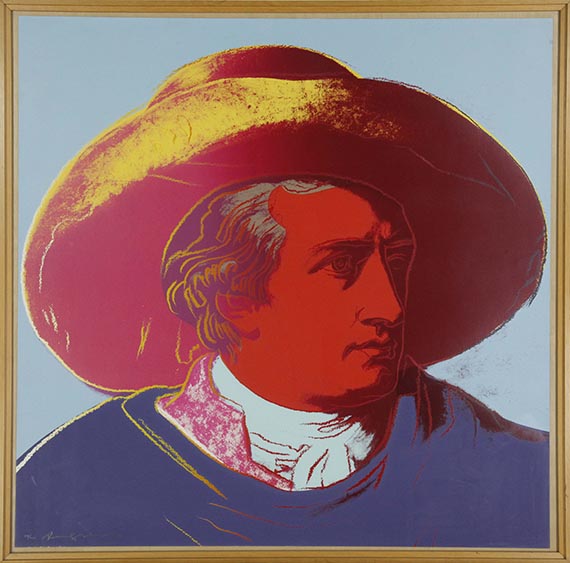60
Andy Warhol
Goethe, 1982.
Silkscreen in colors
Estimate:
€ 60,000 / $ 66,000 Sold:
€ 139,700 / $ 153,670 (incl. surcharge)
Goethe. 1982.
Silkscreen in colors.
Feldmann/Schellmann/Defendi II.271. Signed and numbered. From an edition of 100 copies. On Lenox museum cardboard. 96.5 x 96.5 cm (37.9 x 37.9 in), the full sheet.
Sheet 2 from the portfolio of 4 color silkscreens. Printed by Rupert Jasen Smith, New York (with blindstamp). Published by Editionen Schellmann & Klüser, Munich/New York, in cooperation with Denise René/Hans Mayer, Düsseldorf (with the copyright stamp on the reverse).
• This version of the "Goethe" suite is the one with the strongest colors.
• An icon of world literature portrayed by Warhol.
• Tischbein as a pop art cult motif.
• Part of the same collection since it was made.
PROVENANCE: Galeria Heinrich Ehrhardt, Madrid.
Private collection Spain (since 1982, acquired from the above).
LITERATURE: Forty are better than one. Edition Schellmann 1969-2009, published by Jörg Schellmann, Ostfildern 2009, pp. 342-343.
"People are simply fantastic. You just can't make bad pictures of them."
Andy Warhol, quoted from Feldmann/Schellmann, catalogue raisonné of prints, 1989, p. 8.
Silkscreen in colors.
Feldmann/Schellmann/Defendi II.271. Signed and numbered. From an edition of 100 copies. On Lenox museum cardboard. 96.5 x 96.5 cm (37.9 x 37.9 in), the full sheet.
Sheet 2 from the portfolio of 4 color silkscreens. Printed by Rupert Jasen Smith, New York (with blindstamp). Published by Editionen Schellmann & Klüser, Munich/New York, in cooperation with Denise René/Hans Mayer, Düsseldorf (with the copyright stamp on the reverse).
• This version of the "Goethe" suite is the one with the strongest colors.
• An icon of world literature portrayed by Warhol.
• Tischbein as a pop art cult motif.
• Part of the same collection since it was made.
PROVENANCE: Galeria Heinrich Ehrhardt, Madrid.
Private collection Spain (since 1982, acquired from the above).
LITERATURE: Forty are better than one. Edition Schellmann 1969-2009, published by Jörg Schellmann, Ostfildern 2009, pp. 342-343.
"People are simply fantastic. You just can't make bad pictures of them."
Andy Warhol, quoted from Feldmann/Schellmann, catalogue raisonné of prints, 1989, p. 8.
In the 1970s and 1980s, Warhol focused on portraits and still lifes, and retained screen printing as the sole technique of his graphics and paintings. Silkscreen printing as an artistic medium is just as far from the spontaneous painting gesture as serial production is from an original artwork. With Warhol, however, the poignancy of a motif lies precisely and only in the sum of the images. The underlying design principle here, as in many other works, is the variation of the same iconographic theme. His portraits continue the series of celebrities from film, music, sports and he also added figures from politics and history, like our Goethe. Warhol became the leading portraitist of his time, a fame that reverberates to this day. The Goethe portrait is the first in a series of works using a historical work of art as a reference. For "Goethe", Warhol used a section from what probably is the best-known portrait of the German poet, the one that Johann Heinrich Wilhelm Tischbein painted in 1787 and which is in possession of the Städel in Frankfurt today. In his late portraits, he revisited the simplicity and directness of the silkscreens from the 1960s, however, he added innovative twists. In the Goethe series, Warhol added graphic elements, unlike it is the case with the series of Marilyn portraits, in which he exclusively worked with colored surfaces. In addition to the principle of color variations introduced in the 1960s, the picture is distinguished by graphic lines. While Warhol often used photographic templates for his portrait series, pictures he found in the media or his own Polaroids, he made the effort to visit the Städel Museum in Frankfurt to see the original work that the Goethe series is based on. The publisher Siegfried Unseld invited the pop artist to Germany with the commission to create a variation of Tischbein's painting "Goethe in the Roman Campagna". Photographer Barbara Klemm captured the moment when Warhol, wearing a backpack and with tired eyes, stood in front of the famous painting just like one of many tourists. Based on a photograph, the "court painter of the 70s", as the art historian Robert Rosenblum called Warhol (cf. Robert Rosenblum, Andy Warhol: Der Hofmaler der Siebziger, in: ex. cat. Andy Warhol, Porträts, Museum of Contemporary Art, Sydney 1993; Anthony d'Offay Gallery, London 1994, Munich 1993), transformed the portrait of Goethe into a trendy modernist portrait. [SM]
60
Andy Warhol
Goethe, 1982.
Silkscreen in colors
Estimate:
€ 60,000 / $ 66,000 Sold:
€ 139,700 / $ 153,670 (incl. surcharge)




 Lot 60
Lot 60 

